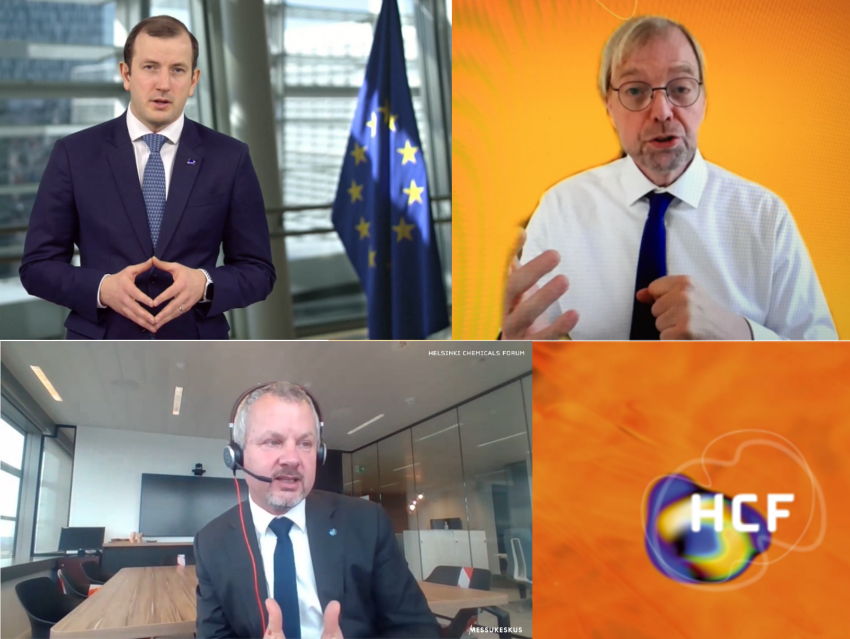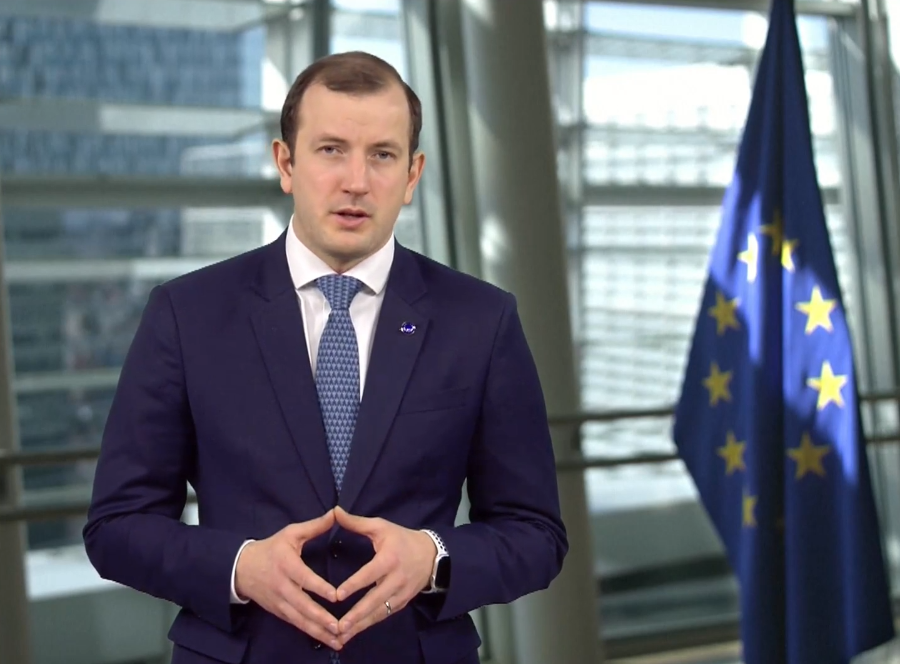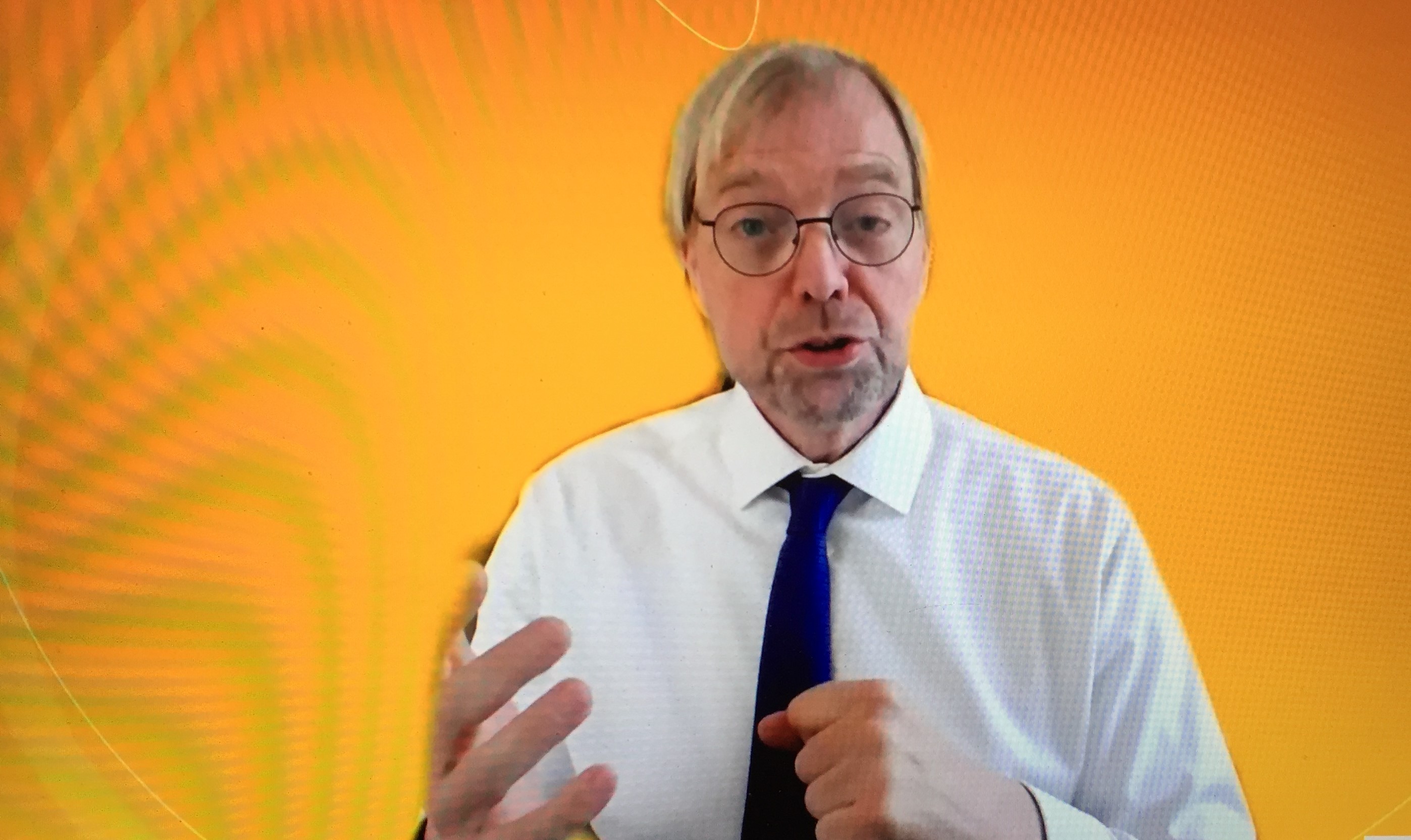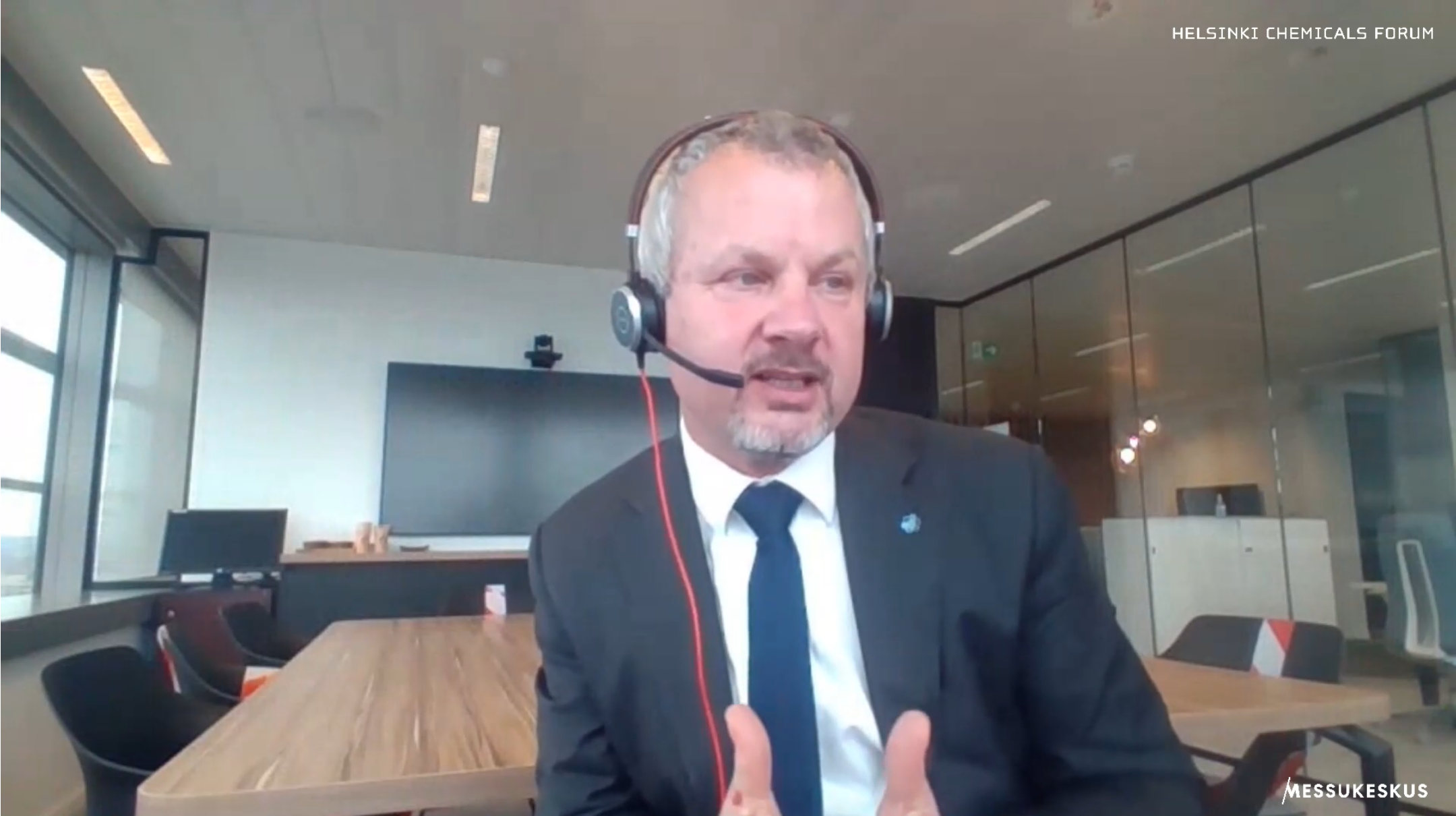The development and challenges of European and global chemicals safety as well as related legislation were discussed at the 12th Helsinki Chemicals Forum (HCF 2021). As the ongoing coronavirus pandemic continues to severely impact the ability to travel, the meeting was held online. Geert Dancet, HCF Secretary-General, was pleased that the online event succeeded in attracting more participants than previous physical events. Well over 200 experts from around the world participated from April 27 to 28, 2021.
The proven concept of the physical meetings in Helsinki, Finland, was maintained: In short presentations and panel discussions, international experts exchanged views on topics such as the Green Deal and the new EU chemicals strategy, chemicals and waste management, safer substitution, and transparency and risk communication. The discussions aimed to find out what has already been achieved, what obstacles remain, and what incentives are useful for further progress.
1 European Green Deal – Striving to be the First Climate-Neutral Continent
Climate change and environmental degradation are existential threats to the world. To address these challenges, the European Union has adopted the Green Deal in December 2019 [1].
The main aim is that there will be no net emissions of greenhouse gases in the EU by 2050, making Europe the world’s first “climate-neutral bloc” by 2050. In addition, economic growth will be decoupled from resource consumption, and no person or place should be left behind in this transformation. The Green Deal is intended to be a growth strategy that transforms the European Union into a modern, resource-efficient, and competitive economy.
Chemicals Strategy for Sustainability – Towards a Toxic-Free Environment
As stated in the Green Deal’s “zero pollution” ambition, the EU’s Chemicals Strategy for Sustainability is intended to help achieve a “toxic-free environment” [2–4]. The strategy was published in October 2020 and comprises over 50 measures that will have far-reaching consequences for the chemical industry and users of chemical products. Examples include a zero-pollution target for a toxic-free environment, a new package for the circular economy, and greater promotion of European standards worldwide.
Currently, the strategy is a communication with an indicative action plan to be implemented. Translating these promises into legislative proposals and concrete actions will be a major challenge and responsibility for the coming years. The plan is to amend and tighten many regulations such as REACH and CLP.
REACH
REACH (Registration, Evaluation, Authorization, and Restriction of Chemicals) is the European Union’s (EU) chemicals regulation. The EU enacted the REACH regulation in June 2007, to better protect people and the environment from harmful chemicals [5].
REACH requires all companies that manufacture or import chemical substances into the EU in quantities of one ton or more per year to register them with the European Chemicals Agency (ECHA) in Helsinki, Finland. It is the responsibility of industry/the companies to prove whether a substance is safe and to show how their chemicals can be used safely.
The EU REACH remains the most comprehensive regulatory framework for chemicals in the world. As part of the EU’s Chemicals Strategy for Sustainability, it is planned to amend and tighten the REACH Regulation.
CLP
The Classification, Labeling, and Packaging (CLP) Regulation requires all importers and manufacturers of hazardous substances placed on the EU market, as well as all substances subject to registration under REACH, to notify ECHA of the classification and labeling of their substance within one month of its placement on the market.
As part of the EU’s Chemicals Strategy for Sustainability, it is planned to amend and tighten the CLP Regulation. The new strategy includes, for example, the inclusion of new hazard classes in the CLP Regulation.
2 The Ambitious Vision and Objectives of the European Commission
The HCF was opened by Virginijus Sinkevičius, the EU Commissioner for Environment who provided a brief overview of the new EU Chemical Strategy for Sustainability. Virginijus Sinkevičius is a Lithuanian politician and since 2019 a European Commissioner. He received a Bachelor of Economic and Social Studies from Aberystwyth University, UK, in 2012, and a Master of Arts in European Studies from Maastricht University, The Netherlands, in 2013.
Virginijus Sinkevičius described that chemicals are everywhere, contributing to our well-being, protecting our health, and keeping us safe. They are fundamental to ensuring our comfort, as the pandemic has made very clear. The chemical industry is the fourth largest industry in Europe and an essential building block for our future. A sustainable future cannot be achieved without chemistry, but chemicals also contribute to pollution and disease. Virginijus Sinkevičius pointed out that European citizens are still too exposed to harmful chemicals, mainly through consumer products. The Chemicals Strategy for Sustainability should change this.
He is aware that it is an ambitious undertaking to raise the level of protection for health and the environment and to transform industry, making it more sustainable, climate-neutral, circular, and free of toxins. Virginijus Sinkevičius explains that the new EU Chemicals Strategy aims to achieve this goal with tangible actions in three different areas.
Increasing Protection
The use of the most harmful chemicals is to be eliminated. This includes endocrine disruptors, and especially their presence in consumer products, in particular, in toys, childcare articles, cosmetics, food contact materials, and textiles. The Commission is preparing a roadmap for adoption this year, using REACH to prioritize restrictions of the most harmful chemicals.
Discussions have also begun on defining what constitutes “essential uses of chemicals”, particularly in consumer products. This concept should allow the use of the most harmful chemicals only when their use is essential to society and no acceptable alternatives are available. The restriction of per- and polyfluoroalkyl substances (PFASs) is a top priority here, as they are highly persistent and cause enormous environmental and health damage. This approach will be consolidated next year with the proposal to revise sectoral legislation and update REACH.
Innovation
The second area involves innovation, especially to drive the development of alternatives. New chemicals and materials are needed, but they must be designed to be safe and sustainable from production to end-of-life. This is referred to as “sustainable and safe-by-design chemicals” in the EU Chemicals Strategy.
Virginijus Sinkevičius said they are working to develop the criteria that will drive research in this direction. An EU-wide support network and a new research and innovation agenda for chemicals are planned.
Legal Framework
The third area is the regulatory framework. The idea of “one substance – one assessment” for chemicals is expected to deliver simplification, cost savings, transparency, and better regulatory predictability in risk assessment. Important cornerstones are a central coordination mechanism, better coordination or distribution of tasks between agencies, and access to all available data in the same structured format.
In addition, compliance will be strengthened: “No data, no market”. The basic principle means that substances may not be placed on the market without prior registration. Enforcement will be strengthened with more audits and more frequent checks of products and chemicals.
We Can Do It
Taken together, these three areas form the strategy that will enable the EU to play a leading role on the global stage, Virginijus Sinkevičius said. It is also very important to help the EU’s partners and strengthen their sustainability efforts, he added. Therefore, legislation will be changed to ensure that chemicals that are banned in the EU cannot be produced for export. This is the bare minimum to ensure the EU’s credibility, he said.
Virginijus Sinkevičius is very proud of this strategy. “I know there is still a lot to do. But I also know we can do it. We can work with all stakeholders. We can deliver on this vision of a toxic-free environment. We can maximize the safe contribution of chemicals to society, and we can avoid harm to the planet and to future generations. I am sure they will thank us for that.”, he concluded.
3 How Well is ECHA Prepared?
ECHA’s Executive Director Björn Hansen gave a keynote speech on the functioning of REACH and CLP. The mathematician is ECHA’s legal representative responsible for day-to-day operations and all personnel matters.
He concluded that REACH and CLP are successful, but improvements are still needed. The Chemical Strategy basically means that the goals of chemicals legislation are a moving target. It sets even higher objectives than those that were originally set in REACH, Björn Hansen said. He is convinced that dealing with chemicals in groups will help to meet the challenges of the EU’s Chemicals Strategy.
Registration
Companies are responsible for collecting information on the properties and uses of substances that they manufacture or import into the EU in amounts of over one ton per year. They must also evaluate the hazards and potential risks of the substance. This information is communicated to ECHA via a registration dossier. Registration is based on the “one substance, one registration” principle. This means that manufacturers and importers of the same substance have to submit their registration jointly.
With registration, the responsibility is on the industry throughout the supply chain. Björn Hansen said that overall, industry has made enormous efforts to comply with REACH. But in his opinion, we are not as far as we would have expected to be by now at the start of REACH. Especially in the supply chain, communication is not yet as smooth as we would have liked. One of the obstacles to this smooth communication is the lack of standardization, harmonization, and digitalization of all communication.
According to Björn Hansen, another problem that hinders implementation in the supply chain is the interaction between REACH and other legislation. As long as there is no seamless implementation of obligations arising, for example, in the workplace from labor legislation, worker protection legislation, and REACH and CLP, there will be inefficiencies in the system that lead to less protection.
Evaluation
ECHA and the Member States evaluate the information submitted by companies to check the quality of the registration dossiers and to clarify whether a particular substance poses a risk to human health or the environment.
Overall, ECHA believes that the evaluation process is working reasonably well. In terms of testing proposals and compliance checks, ECHA has made big steps forward in recent years not only in achieving the objectives but in making these processes much more efficient. The agency has almost doubled the number of compliance checks.
Björn Hansen feels that the resources provided by the Member States for substance evaluation are often insufficient. Lawyers, for example, should be involved in the process right from the start, since substance evaluation is ultimately a legally sound decision that has to hold up in court.
Authorization
The authorization process is designed to ensure that substances of very high concern (SVHC) are progressively replaced by less hazardous substances or technologies. The prerequisite is that technically and economically feasible alternatives are available. A Member State, or ECHA at the request of the Commission, may propose a substance to be identified as SVHC.
Björn Hansen thinks the authorization system fulfills its goals and promotes safety and substitution of substances, but he considers the level of detail in the approval system to be inefficient and believes that another obstacle is the lack of incentives to gather and maintain knowledge about alternatives and bring it into the process in a timely manner.
Restriction
Restrictions may limit or prohibit the manufacture, placing on the market, including imports, or use of a substance. They may also impose conditions, such as requiring technical measures or specific labeling.
Björn Hansen and his team feel that restrictions have been moving in the right direction. ECHA has continuously improved on the REACH restrictions side and has now reached the stage where they can look at groups of substances. They can be much more categorical, much more generic, without sacrificing the science that underpins the restriction itself.
EU’s Chemicals Strategy
Summing up, Björn Hansen says that overall, all stakeholders together have made a lot of progress, but that there is still a lot to be done, especially with the new higher targets that are set in the Chemical Strategy. But overall, he believes that ECHA, together with all its partners, the Member States, industry, the stakeholder organizations, and the Commission, is in a pretty good position to take on the additional new challenges.
5 How Ambitious is the EU Chemicals Policy in the Eyes of Chemical Industry?
The European Chemical Industry Council (Cefic), like the European Commission, wants to maintain a system that provides a high level of protection for people and the environment and supports industry investment in safer and more sustainable substances. Nevertheless, Marco Mensink, Cefic Director-General, notes that the chemical industry is probably the only sector facing a quadruple challenge: In addition to the green and digital transformation that all other sectors must also undergo, the chemical industry has the additional challenge of the circular economy and the sustainability strategy for chemicals that must be met by 2050.
With the Green Deal, an unprecedented level of regulatory change is on the horizon in the next few years. It is the biggest regulatory overhaul since REACH. Therefore, it is important to put all the steps in place for a concrete plan with reliable measures to implement the goals, and to become more predictive in forecasting the hazard classes of chemicals to ensure that the necessary investments can be made. Innovation will enable the chemical industry to make this change. Therefore, the concept of “safe and sustainable by design” must be advanced in this context.
Maintaining the competitiveness of the EU industry despite a growing regulatory gap between the EU and other regions of the world that have less advanced chemicals legislation is an important point to consider. Marco Mensink noted that a key issue is not only how to make the EU chemical industry more sustainable, but also how to get other regions to follow the EU’s lead.
6 Conclusion
The overall picture is that the implementation of the EU Chemicals Strategy does not only concern the chemical industry but all value chains that use chemicals. The adoption of the strategy was only a starting point and further discussions are needed to develop a coherent implementation. A careful impact assessment is of utmost importance for the success of the strategy but also to ensure that the European industry is competitive and gains those first-mover advantages.
References
[1] A European Green Deal, Webpage of the European Commission (Accessed May 5, 2020)
[2] Chemicals strategy The EU’s chemicals strategy for sustainability towards a toxic-free environment, Webpage of the European Commission (Accessed May 7, 2020)
[3] Chemicals Strategy for Sustainability Towards a Toxic-Free Environment, European Commission, Brussels, Belgium October 14, 2020.
[4] The Chemicals Strategy for Sustainability: How Can the EU set an Example for the World?, Center for International Environmental Law (CIEL), January 2021. (Accessed May 7, 2021)
[5] REACH – An Overview, ChemistryViews 2012. https://doi.org/10.1002/chemv.201200029
Also of Interest
- All panel discussions and keynote speeches of HCF can be accessed for a fee
- The next Helsinki Chemicals Forum will be held on March 30–31, 2022,
at the same time with ChemBio Finland, the event for the chemistry and biotechnology professionals in the Nordic Countries and Baltic regions







